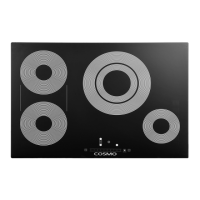41
Cleaning Methods:
• While the cooktop is still warm, use a single-edge razor blade scraper at
approximately a 30° to 45° angle against the glass surface and scrape
the soil. It will be necessary to apply pressure to the razor scraper in order
to remove the residue.
• When the cooking surface is completely cooled, spread a few drops of
ceramic cooktop cleaner on the entire burned residue area. Using a non-
scratch cleaning pad for ceramic cooktops, rub the residue area, applying
pressure as needed. Leave the cleaner on for 10 minutes before rinsing it
off.
• Rinse with clear water and wipe the cooktop surface with a clean, dry
paper towel.
NOTE:
• Do not use a dull or nicked blade.
METAL MARKS AND SCRATCHES
• Cookware with rough or uneven bottoms can mark or scratch the cooktop
surface. Carefully check the bottom of pans.
• Do not slide metal or glass across the cooktop surface.
• Do not use cookware with any dirt build-up on the bottom.
• Always clean the cooktop surface before cooking.
• Be careful not to place aluminum baking sheets or aluminum frozen
entrée containers on a hot cooktop surface. It will leave shinny dots or
markings on the cooktop surface. These markings are permanent and
cannot be cleaned off.
Cleaning Methods:
• Be careful not to slide pots and pans across your cooktop. It will leave
metal markings on the cooktop surface. These marks are removable using
the ceramic cooktop cleaner with a non-scratch cleaning pad for ceramic
cooktops.
• If pots with a thin overlay of aluminum or copper are allowed to boil dry,
the overlay may leave black discoloration on the cooktop. This should be
removed immediately before heating again or the discoloration may be
permanent.

